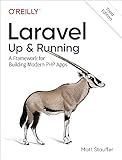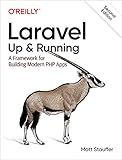Best Laravel Route Definition Guides to Buy in October 2025

Laravel: Up & Running: A Framework for Building Modern PHP Apps



Laravel: Up & Running: A Framework for Building Modern PHP Apps



Ultimate Laravel for Modern Web Development: Build Robust and Interactive Enterprise-Grade Web Apps using Laravel's MVC, Authentication, APIs, and Cloud Deployment (English Edition)



Architecture of complex web applications. Second Edition.: With examples in Laravel(PHP)



Laravel: Up and Running: A Framework for Building Modern PHP Apps



Practical Laravel: Develop clean MVC web applications



Laravel: Learn By Coding


In Laravel, routes act as an interface between the user and the application. They define the URL structure and determine how the application responds to different HTTP requests. To define routes in Laravel, you can follow these steps:
- Routes are typically defined in the routes/web.php or routes/api.php file, depending on whether it's a web or API route. You can create custom route files as well.
- Routes can be defined using the Route facade or using a closure function. The facade provides various methods like get, post, put, delete, etc., to define routes for different HTTP methods.
- For example, to define a GET route, you can use the Route::get() method. The first parameter is the URL path, and the second parameter is the closure function or controller method that handles the request. Inside the closure or method, you can define the logic for processing the request and returning a response.
use Illuminate\Support\Facades\Route;
Route::get('/welcome', function () { return view('welcome'); });
- Parameters can be passed in the route URL using curly braces. These parameters can be accessed within the closure function or controller method.
Route::get('/user/{id}', function ($id) { return 'User ID: ' . $id; });
- Route parameters can have constraints to restrict the parameter value format. For example, you can specify that an ID parameter should only contain numbers.
Route::get('/user/{id}', function ($id) { // })->where('id', '[0-9]+');
- You can also give a name to a route using the name method. Named routes can be referred to easily in the application.
Route::get('/user/profile', function () { // })->name('profile');
- Route groups allow you to apply common attributes to multiple routes, such as middleware or namespace. It helps to organize and maintain routes efficiently.
Route::prefix('admin')->group(function () { Route::get('users', function () { // }); Route::get('roles', function () { // }); });
- Once routes are defined, you need to run the application using the php artisan serve command or a web server like Apache or Nginx. This allows the application to listen for incoming requests and handle them based on the defined routes.
These are the basic steps involved in defining routes in Laravel. Understanding routes is crucial for building a web application with Laravel.
How to define a route for handling file downloads in Laravel?
To define a route for handling file downloads in Laravel, follow these steps:
- Open the routes/web.php file in your Laravel project.
- Add a new route using the Route::get() method. Specify the route URL and a callback function to handle the request. For example:
Route::get('/download/{file}', 'DownloadController@downloadFile')->name('download');
This route specifies that any request to /download/{file} will be handled by the downloadFile method of the DownloadController controller. The {file} parameter will be passed to the method.
- Create the DownloadController using the artisan command: php artisan make:controller DownloadController.
- Open the newly created DownloadController file at App\Http\Controllers\DownloadController.php.
- In the DownloadController, define the downloadFile method to handle the file download. The method should receive the {file} parameter and use it to locate the file and send it as a response. Here is an example:
public function downloadFile($file) { $path = storage_path('app/files/' . $file);
if (file\_exists($path)) {
return response()->download($path);
} else {
abort(404, 'File not found');
}
}
In this example, we assume that you store your files in the storage/app/files directory. The response()->download() method is used to create a download response for the file.
Note: Make sure to modify the file path based on your application's directory structure and naming conventions.
- Save the changes and test the file download by visiting the defined URL, e.g., /download/file.txt. The file should start downloading automatically.
That's it! You have successfully defined a route for handling file downloads in Laravel.
What is the difference between GET and POST routes in Laravel?
In Laravel, GET and POST routes are used to handle different types of HTTP requests.
- GET Routes:
- GET routes are used to retrieve data from the server.
- GET requests can be used to fetch data from a specific URL, such as retrieving a page, accessing a specific resource, or performing a search operation.
- GET requests are visible in the URL, which means the parameters or data sent through the URL can be seen by users and search engines.
- GET routes are idempotent, i.e., multiple identical requests will have the same effect as a single request.
- POST Routes:
- POST routes are used to submit data to be processed on the server.
- POST requests are not visible in the URL, which means the data sent through POST requests cannot be seen by users and search engines.
- POST requests are commonly used to submit forms, create new resources, or perform actions that modify data on the server.
- POST routes are not idempotent, i.e., multiple identical requests can have different effects each time.
In summary, GET routes are used for retrieving data from the server, while POST routes are used for submitting data to be processed on the server.
How to define a route with multiple HTTP methods in Laravel?
To define a route with multiple HTTP methods in Laravel, you can use the match or any methods provided by the Route facade. Here's how you can do it:
- match method: The match method allows you to specify an array of HTTP methods that the route should respond to. Here's an example:
use Illuminate\Support\Facades\Route;
Route::match(['get', 'post'], '/example', function () { // Route logic here });
In this example, the /example route will respond to both GET and POST requests.
- any method: The any method allows the route to respond to any HTTP method. Here's an example:
use Illuminate\Support\Facades\Route;
Route::any('/example', function () { // Route logic here });
In this example, the /example route will respond to all types of HTTP methods.
Note: You can replace the closure function in the above examples with a controller action if you prefer using controllers.
You can also use the Route facade using a fluent interface to define multiple methods. For example:
use Illuminate\Support\Facades\Route;
Route::prefix('example')->group(function () { Route::get('/', 'ExampleController@index');
Route::post('/', 'ExampleController@store');
Route::put('/', 'ExampleController@update');
// And so on...
});
In this example, the /example route responds to GET, POST, PUT, and other HTTP methods.
These are some of the ways you can define a route with multiple HTTP methods in Laravel. Choose the method that suits your requirements.
How to pass parameters in a route definition in Laravel?
To pass parameters in a route definition in Laravel, you can use route parameters. Here's how you can do it:
- Define a route in your web.php or api.php file:
Route::get('/user/{id}', 'UserController@show');
This route accepts a parameter named {id}.
- In the corresponding controller method, you can receive the parameter using the same name as defined in the route definition:
public function show($id) { // Use the $id parameter in your logic }
The $id parameter will contain the value passed in the route URL.
- You can then generate URLs for this route using the route() or url() helper functions:
$url = route('user.show', ['id' => $userId]);
In the above example, $userId is the value you want to pass as the {id} parameter in the route URL.
You can also use route parameters with other HTTP verbs like POST, PUT, PATCH, and DELETE by defining the corresponding routes with route parameters.
